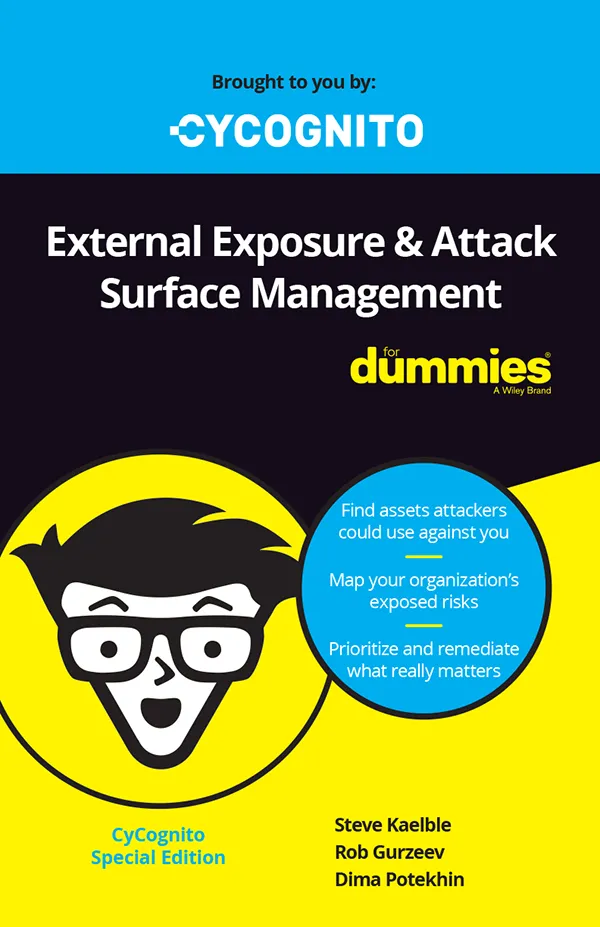



Reconnaissance is a crucial phase in cybersecurity, representing the initial groundwork before any cyber offensive or defensive operation. It involves collecting information about a target system to understand its vulnerabilities and strengths. This process is vital for both attackers and defenders, assisting hackers in planning their techniques while enabling security teams to anticipate potential threats.
By understanding the methods attackers may use, cybersecurity professionals can formulate strategies to thwart potential breaches. Reconnaissance aids in identifying weak spots in a network's armor, offering an early warning system against possible intrusions. Whether for penetration testing or developing a security strategy, reconnaissance remains a cornerstone of proactive defense.
This is part of a series of articles about Exposure Management.
Active reconnaissance involves direct interaction with a target system to gather intelligence. This approach often includes techniques such as scanning ports, running vulnerability assessments, or exploiting security gaps to obtain detailed insights.
Unlike passive reconnaissance, active methods are more intrusive, potentially alerting the target to the reconnaissance activities. Despite this risk, active reconnaissance provides current and detailed information, making it a useful tool in both offensive and defensive cybersecurity operations.
Typically, active reconnaissance is used by security professionals during penetration testing to simulate an attack. By proactively testing a system's defenses, organizations can identify and remediate vulnerabilities before they are exploited by malicious actors. However, due to its intrusive nature, active reconnaissance may lead to detection and potential legal consequences if conducted without proper authorization. It requires careful handling and should only be performed by or under the supervision of qualified cybersecurity experts.
Related content: Read our guide to automated pentesting.
The primary benefit of active reconnaissance is the accuracy and detail of information it provides. By directly engaging with a target system, active methods uncover real-time data about vulnerabilities, configuration issues, and the system's defensive posture. This level of detail is invaluable for organizations seeking to fortify their cybersecurity measures and understand their risk landscape.
However, active reconnaissance comes with significant limitations, mainly the risk of detection. Such operations can trigger alerts within the target system's security infrastructure, possibly leading to legal issues if performed without consent.
Active reconnaissance can also inadvertently disrupt system operations, leading to downtime or other negative consequences. Thus, while it offers detailed insights, it must be employed sparingly and executed by competent professionals within legal boundaries to mitigate its risks.
Passive reconnaissance focuses on gathering information about a target system without direct interaction. Techniques might include analyzing publicly available data, as in DNS enumeration, monitoring social media activity, or scanning internet databases. Unlike its active counterpart, passive reconnaissance aims to remain undetected by avoiding direct engagement with the target system. This approach allows attackers and security teams alike to collect valuable intelligence with minimal risk of exposure.
Typically, passive reconnaissance is used in the early phases of a security assessment to identify potential entry points into a system. It relies heavily on open-source intelligence (OSINT) and other publicly accessible resources to build a picture of the target. Since passive methods do not touch the target system directly, they offer a safer alternative for preliminary research.
Learn about the discovery features of CyCognito, our Attack Surface Management platform.
The primary benefit of passive reconnaissance is its low risk of detection. By avoiding direct interaction with the target system, it allows for discreet intelligence gathering. This makes passive reconnaissance a tool for both attackers planning their strategy and defenders understanding potential vulnerabilities without alerting adversaries.
However, passive reconnaissance has limitations, primarily the reliance on publicly available data. This means that the information gathered may not be as current or detailed as that obtained via active methods.
Additionally, passive techniques might miss internal vulnerabilities inaccessible from public channels. While useful for broad analysis, passive reconnaissance might require supplementation with active techniques to gain a full understanding of a system's security posture.

Rob Gurzeev, CEO and Co-Founder of CyCognito, has led the development of offensive security solutions for both the private sector and intelligence agencies.
In my experience, here are tips that can help you better implement effective reconnaissance strategies:

As your attack surface has grown to cloud infrastructures and across subsidiaries, attackers are looking for and finding unknown and unmanaged assets to serve as their entry points.
Active reconnaissance techniques involve direct engagement, making them more aggressive and intrusive. Common techniques include:
Passive reconnaissance techniques involve gathering information without directly interacting with the target. They include:
Active reconnaissance requires advanced technical skills due to the direct interaction with the target system. Professionals conducting active reconnaissance need proficiency in networking protocols, familiarity with scanning tools (e.g., Nmap, Nessus), and experience interpreting results from network traffic analysis.
Additionally, a deep understanding of system vulnerabilities, firewall configurations, and intrusion detection systems (IDS) is crucial to avoid triggering alerts. Ethical hacking knowledge and legal expertise are also important, as practitioners must navigate the legal boundaries of active engagement to avoid unauthorized intrusions.
Passive reconnaissance demands strong research abilities and a solid grasp of open-source intelligence (OSINT) tools. Analysts must be skilled at using resources like WHOIS databases, DNS records, and social media platforms to extract valuable insights without direct system interaction.
Familiarity with data aggregation tools (such as Maltego or Recon-ng) is beneficial. Furthermore, an understanding of privacy laws and ethical standards is necessary to ensure compliance when collecting and analyzing publicly available information.
Active reconnaissance significantly increases the risk of detection since it involves direct interaction with the target system. This interaction can trigger alerts and defensive actions by security systems, potentially compromising the reconnaissance operation. Therefore, when engaging in active reconnaissance, cybersecurity experts must carefully manage their methods to minimize this risk, conducting activities in a legal and ethical manner.
Passive reconnaissance maintains a low profile as it does not interact directly with the target systems, thereby minimizing the likelihood of detection. This approach offers the advantage of gathering information without tipping off a potential adversary or alerting the system's defenses. While passive techniques are inherently safer in terms of stealth, the trade-off is the possibility of less comprehensive data compared to active methods.
Active reconnaissance often provides more accurate and detailed data since it involves direct probing of the system for real-time insights. This in-depth intelligence is invaluable for pinpointing specific vulnerabilities and understanding the target's security landscape. However, the accuracy of active reconnaissance depends on the tools and methods employed, as well as the expertise of the individuals conducting the operation.
Passive reconnaissance, while stealthier, might produce less precise data due to its reliance on publicly accessible information. The accuracy of passive data is contingent on the quality and recency of available sources. While sufficient for identifying broad vulnerabilities, passive data may not capture real-time threats or system changes.
Active reconnaissance often raises more significant legal and ethical concerns due to its intrusive nature. Without explicit permission, actively probing system vulnerabilities can be seen as unauthorized access, leading to potential legal ramifications for those involved. Even when ethically justified, security professionals must ensure compliance with laws and regulations to avoid legal complications and uphold ethical standards in cybersecurity practices.
Passive reconnaissance typically poses fewer legal challenges since it involves reviewing publicly available information. Despite its lower risk, passive reconnaissance still requires adherence to privacy laws and ethical considerations. Organizations must ensure these methods do not infringe on individual privacy rights or violate data protection regulations, maintaining ethical principles throughout the information-gathering process.
Active reconnaissance demands significant time and resources due to the complexity of methods involved and the risk to the tested systems. It often requires specialized tools and expertise to effectively probe and analyze target systems, making it resource-intensive. This can result in higher operational costs, both in terms of technology investment and the time required for skilled personnel to conduct and interpret results accurately.
Passive reconnaissance is generally less resource-demanding, leveraging publicly available information to assemble a target profile. Although it requires less direct investment in tools and manpower, passive reconnaissance can still be time-consuming, particularly when extensive data collection and analysis are needed.
Choosing between passive and active reconnaissance depends on the objectives, risk tolerance, and legal boundaries of the operation.
Passive reconnaissance is best suited for the initial stages of a cybersecurity assessment or when discretion is paramount. Its low risk of detection makes it ideal for gathering a broad understanding of a target’s infrastructure without triggering security defenses. It is commonly used for early research, competitive intelligence, or identifying general vulnerabilities that may be exploited later.
For attackers, it provides an opportunity to build a profile without alerting the target, while for defenders, it offers insights into publicly exposed information that could be leveraged by adversaries. Passive methods are also useful when legal or ethical constraints limit more intrusive techniques, as they typically involve reviewing data that is already publicly accessible.
Active reconnaissance is best suited when detailed, real-time information is required. Security professionals often employ active methods during penetration tests or vulnerability assessments to simulate real-world attacks. It is especially useful for probing specific systems, testing defenses, or uncovering hidden vulnerabilities that passive techniques cannot reveal.
However, due to its intrusive nature, active reconnaissance should only be performed with explicit authorization and careful risk management. It is most effective in environments where the priority is to identify and fix vulnerabilities quickly, even if it involves a higher chance of detection.
Ultimately, the choice between passive and active reconnaissance depends on the need for detailed intelligence versus the desire to remain undetected. Organizations often use both methods in combination, starting with passive reconnaissance to gather initial data, and then transitioning to active methods for deeper analysis.
CyCognito delivers an innovative approach to reconnaissance through its external attack surface management (EASM) platform, combining active and passive techniques to replicate an attacker’s methodologies. Built by experts from a globally recognized intelligence agency, CyCognito integrates logic, probability, and open-source intelligence (OSINT) into a well-orchestrated decision-making framework for uncovering hidden vulnerabilities.
The platform automates reconnaissance and asset discovery using an interconnected network of over 60,000 systems and a graph data model that dynamically represents an organization’s attack surface. This model connects machines, applications, cloud instances, and files, helping security teams understand their exposure and risks in detail.
Key Features of CyCognito:
CyCognito transforms reconnaissance into a scalable, automated, and efficient process, empowering security teams to reduce risks and operational inefficiencies while maintaining a clear view of their evolving attack surface.
Learn more about CyCognito.

As your attack surface has grown to cloud infrastructures and across subsidiaries, attackers are looking for and finding unknown and unmanaged assets to serve as their entry points.